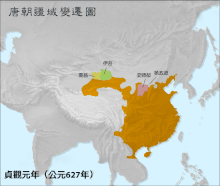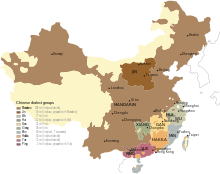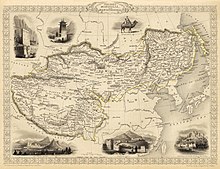File talk:Qing Empire circa 1820 EN.svg
Guizhou is on the map twice, Guangxi should be there. Also I think the Yellow River flowed south of Shandong in 1820. Nice map otherwise. Cobblet (トーク) 19:09, 30 December 2015 (UTC)
Pre-Qing vs Ming[編集]


@Philg88: I believe there is an error in the description of yellow part as "Pre-Qing Han territory", it should be Ming territory instead probably. The Tang dynasty Han territory extended on Xiyu (west territories) that is about the Zungary of the time of the Qing. The Uyghurs inhabited and ruled current Mongolia and part of the Siberia at this time. The linguistic repartition of Han language display also this long time expansion of Han languages speaking people.Popolon (トーク) 22:38, 18 August 2019 (UTC)
- The linguistic map only reflects the present-day situation, not the historic situation. The Dzungar Basin of northern Xinjiang saw a massive influx of Han Chinese settlement during the late 19th Century, which mostly fled after the Dungan Revolts. The region was not again settled by large numbers of Han Chinese until the modern period, beginning as a slow stream after 1949 and not picking up speed until decades later with government incentives. The Western Regions during the Tang Dynasty was primarilly inhabited by Indo-European speaking groups such as the Tocharians, Saka, and Sogdians, not Han Chinese as you claim, aside from small numbers of soldiers, monks, merchants, and their families, some of whom assimilated into the local population and others of whom migrated back to eastern China, leaving no lasting presense to modern times.
- Furthermore, you misunderstand the meaning of the map. The reason Xinjiang is not labelled as "pre-Qing territory" is because the map only reflects the situation in relation to the expansion of the Qing. Whatever the political situation was during the Tang Dynasty is irrelevent to this particular map, because it's a map of the Qing, not the Tang. At the time the Qing acquired Xinjiang, it was territory of the Dzungar Khanate. The Qing did not inherit Xinjiang from previous dynasties... It re-conquered it after centuries of control by Central Asian empires. 2601:4A:501:750:9404:5E75:54E9:9DCC 01:18, 29 May 2020 (UTC)
~[編集]
Please see the following sources that discuss the issue in details. Qinglong Emperor claimed tributes based on gift exchanges.
Sources[編集]
- Dai, Yingcong (2004). "A Disguised Defeat: The Myanmar Campaign of the Qing Dynasty". Modern Asian Studies 38: 145–189. Cambridge University Press. DOI:10.1017/s0026749x04001040.
- Burney, Col. Henry (August 1840) Four Years' War between Burmah and China、9、Canton: Printed for Proprietors、4 番
- Fernquest, Jon (Autumn 2006). "Crucible of War: Burma and the Ming in the Tai Frontier Zone (1382–1454)". SOAS Bulletin of Burma Research 4.
- Giersch, Charles Patterson (2006年) Asian borderlands: the transformation of Qing China's Yunnan frontier、Harvard University Press ISBN: 0-674-02171-1.
- Lieberman, Victor B. (2003年) Strange Parallels: Southeast Asia in Global Context, c. 800–1830, volume 1, Integration on the Mainland、Cambridge University Press ISBN: 978-0-521-80496-7.
SSH remoteserver (トーク) 18:34, 13 June 2021 (UTC)
Too many mistakes[編集]
This version has too much wrong, for example, Guizhou should be Guangxi, Canton isn’t Guangdong, and Manchus homeland (Jianzhou Jurchen) located in south part of Manchuria near Shenyang not Heilongjiang — Preceding unsigned comment was added by 103.157.251.50 (talk) 12:34, 16 June 2021 (UTC)

— Preceding unsigned comment was added by 103.157.251.50 (talk) 12:30, 16 June 2021 (UTC)
Borders of Qing and year such as Hami also wrong

— Preceding unsigned comment was added by 103.157.251.50 (talk) 12:43, 16 June 2021 (UTC)
Just confirming as a non-anon account that the anon has correctly identified serious errors, such as Guizhou being duplicated and Guanxi being missing. Conflatuman (トーク) 06:10, 19 October 2023 (UTC)